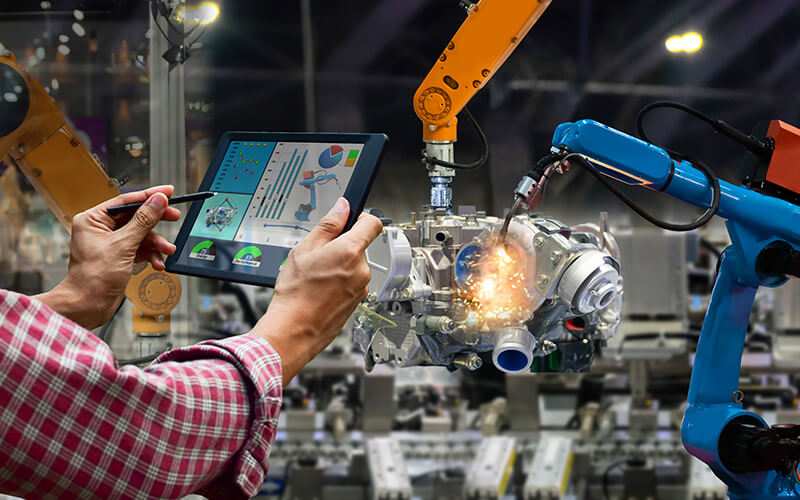manufacturing
Digital Transformation in the Manufacturing Industry
The concept of digitalisation or Industry 4.0 has varying importance in existing industries, but it has caused disruption in each one of them. While some sectors have embraced the concept, others have shied away from implementing it. The trend among information-based products and services businesses is to eventually morph into digital organisations, while others businesses are struggling to encash the opportunities presented by digital transformation. These are two extremes on how the digital revolution has altered the seams of the business landscape. The sectors that have adopted digitalisation have benefited with more streamlined transactions, refined product delivery, and enhanced internal and external value chains.
The explosion in data and new computing capabilities, paired with advances in areas such as artificial intelligence, robotic automation, additive technology, and human–machine interaction, have led to innovations that are changing the basics of manufacturing. Digital manufacturing technologies are revamping every part of the manufacturing value chain, from research and development, supply chain, and factory operations to marketing, sales, and services. The implementation of digital manufacturing and improved workflow processes have altered the landscape of businesses and has delivered considerable cost savings to them.
How has digitalisation affected various industries?
By harnessing the capabilities of workers, designers, managers, and suppliers, as well as accelerating the pace of innovation, lowering the costs of production and maintenance, and intensifying the impact of marketing, businesses have made significant progress in the digital revolution. While no business has harnessed every possible digital advancement, in a market where profit margins are spread thin and consumers seek more sophisticated products and improved service, digital transformation has ushered businesses towards success, while other slow-moving competitors are left behind.
Here's a look at how some sectors have handled digital transformation.
Discrete manufacturing industry
The digital economy is here to stay and will alter the discrete manufacturing industry. By engaging business partners and customers in creative ways, manufacturers can achieve digital value creation. Technologies, such as embedded systems, smart glasses powered by augmented reality software, and geospatial technologies, deliver substantial productivity boost to manufacturing.
Virtual prototyping — a process that relies entirely on digitalisation — reduces or even removes the need for physical prototypes by bringing 3D printing technologies into the picture.
A vast section of the manufacturing industry is still hesitant to embrace digitalisation. Instead, many manufacturing businesses have started to digitalise specific operations. This is due to the amount of coordination and the number of changes that a complete digital transformation demands. Businesses must realise that they need to fully implement digitalisation to benefit from it.
Aerospace and defense industry
To remain competitive and navigate through the enormously complex supply chain network that the aerospace and defense industry demands, digital tools need to be integrated into all levels of production. For example, a modern jet turbine engine requires hundreds of individual parts to be built. The engine manufacturer conceives some of them in-house, while others are outsourced to vendors. The complexity of this outsourcing can quickly become intangible since just one design modification can impact the manufacturing of all other components too.
A digitalised approach with cloud computing–based equipment allows suppliers to work together as a more cohesive and efficient team while ensuring data security. The engine maker can display 3D models of component design, and each supplier, in turn, can share data related to rate, delivery, and quality. Establishing a communication channel makes information sharing transparent, reduces the labor employed to keep track of the design changes, removes ambiguity for the engine maker and suppliers, and updates all the changes across the supply network to everyone involved.
Pharmaceutical industry
With quality, innovation, production optimisation, regulatory compliance, and data integrity being the key drivers of success in the pharma industry, digitalisation is about gaining enterprise-wide insight to build value and save costs, as well as predict and remove inefficiencies.
Pharmaceutical companies can build a deeper understanding of end-to-end processes and create continuous manufacturing suites that leave footprints less than half the size of typical factories. Mobile factories can be built in 40 foot trailers with digital threads for quality control, continuous monitoring, tablet presses, lyophilizers, and other critical equipment. Completely digital labs have processes and tools in place to assist R&D teams in capturing, recording, mining, and analysing data (current and historical) in ways that were impossible with legacy systems.
How does the digital revolution benefit manufacturing?
Improving customer experience:
Enhance customer interactions with new products, apps, and tools.Creating operating efficiency gains:
Revamp internal processes, transform back-end systems, and refresh supplier contracting structures for integrated and simplified operations.Investing in specialised departments or group companies or engaging in partnering arrangements:
Anticipate upcoming changes in the market.Using big data:
Understand customer preferences and buying behavior to transform relationships with big data. Navigate the intricate terrain of data protection, privacy, and cybersecurity laws to unlock the full potential of big data, advanced analytics, and machine learning.
Digital revolution has already made its mark on every industry. Businesses that have adopted complete virtualisation of manufacturing are steaming ahead of businesses that have been reluctant to adopt it. Irrespective of the uptake, digitalisation is here to stay, and if businesses want to remain relevant in this ever-changing landscape, they must completely digitalise and embrace the revolution.





